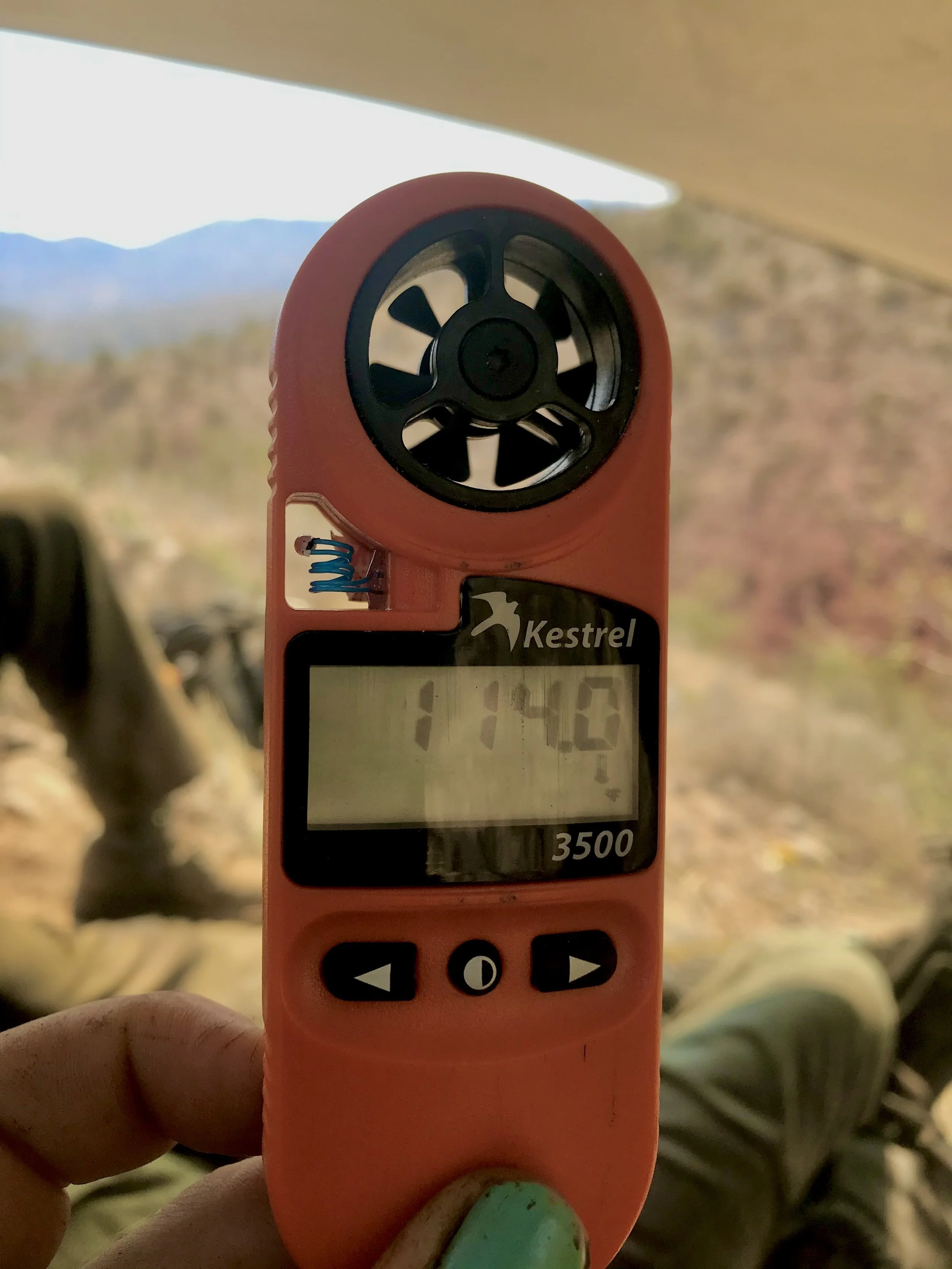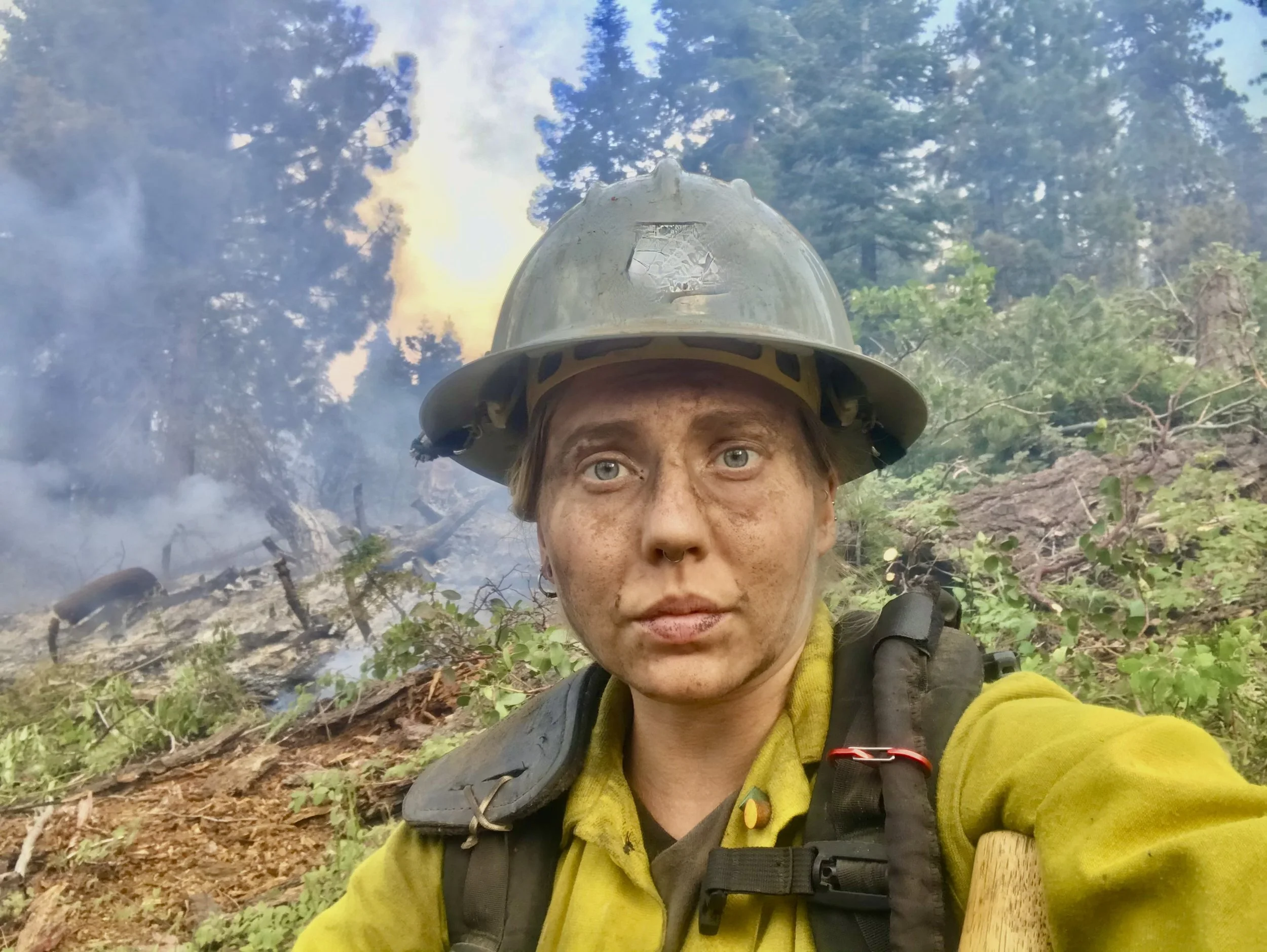Into the Fire
by Emma Ruth Anderson
Emma Ruth Anderson, 114 Degrees Fahrenheit, digital photo, 2021. Courtesy of the author.
Into The Fire
Emma Ruth Anderson | JUly 2025 | Issue 47
A flickering line of fire strung out like glowing beads on the horizon line of the mountains abutting the ballfield we slept in. Or tried to sleep in. I woke up to the tickling legs of dime-sized cockroaches canoodling their way into my sleeping bag and stifled an instinctive scream. The rest of my hotshot crew rustled in their equally vulnerable “cowboy camping” setups. A small tarp laid out on the bare dirt or grass of the baseball field, inflatable sleeping pad and sleeping bag atop the thin strip of woven plastic. Our soot and sweat-soaked bodies tucked inside despite the refusal of the Southwest summer night to cool off after a 100+ degree day. Earlier on shift, we had taken out the sling psychrometers and electronic Kestrels from the weather kits and they wavered between 114 and 117 degrees Fahrenheit. Not to mention the fire.
The really fun thing about working in wildland fire is that not only does the peak firefighting season occur during the scorching peak of summer, but through it all you get to wear thick long pants and long-sleeved clothing made of Nomex, a fire-retardant material that is neither breathable nor particularly flattering on any but the most genetically gifted body. So while you’re out there on some Arizonan hillside, elbow deep digging out the stump hole of some ungodly spiky desert brush, fantasizing about going to the lake at home with your friends, wearing nothing but swimsuits and splashing around on whatever aquatic inflatable you’ve all brought, with a fully stocked cooler of ice cold beverages floating along on the flotilla…and then your bare hand hits the jackpot—a heat! (The "heat" being any lingering ember in the remaining ground fuels, which must be entirely extinguished during the course of the "mop-up" phase of wildland fire operations in order to eliminate the chance of the fire re-igniting and compromising established containment lines.) That’s when you really start questioning your life choices.
And then you keep digging. Scraping, crushing the remnants of charred wood and smoking roots. Making a “bone pile” of the coals as you mix them with dirt, kicking up dust and ash into your already clogged nostrils. Until the smoke peters out. The sparks smothered and suffocated or dampened and drowned. And your job is complete.
“Clear!”
The exclamation echoes down the grid line. You get up and keep moving systematically across your chunk of burned ground, guided by repeating chants of “bump left,” “pivot right,” “hold for heat!”
Of course a grid line rarely moves seamlessly. A new trainee learning the commands or a crew member who’s hard of hearing or someone simply not paying attention starts “bird-dogging” (moving ahead of the person to their right or left), disrupting the flow of the grid, a formation intended to carefully survey the ground for anything still on fire after the flaming front has passed.
Emma Ruth Anderson, Beads of Fire on the Horizon, digital photo, 2021. Courtesy of the author.
A career in wildland firefighting rarely moves seamlessly either. Faced with absurdly low wages for the skills and mental and physical endurance necessary to succeed year after year under interminably challenging conditions, an impossible work-life balance given the demanding schedule of unpredictable 14-day assignments with three days off in between (which, prior to 2021 was only required to be two days off), and many more hurdles that would require an even longer run-on sentence to enumerate on adequately—it is hard to distill the reason why I keep coming back to this work.
And yet I have. For 10 years of summers spent across the wild places of the United States of America. From Virginia to New Mexico to Alaska and California. Six stations, three National Forests, a Bureau of Land Management Veterans Training Crew, a National Park, and a private company contract crew.
The Arizona cockroaches feel like a lifetime away, and yet that was (is) me. Standing there (here) in the heat. “On the front lines of the climate crisis,” as a friend who was on her way to the Yale School of Forestry once told me. I cringed at the audacious tone of that statement at the time. Seeing as the brunt of the job of a ground resource crewmember involves moving dirt and logs out from the path of the oncoming fire with handtools and chainsaws, spraying water at the flickering flames, or crawling across the scorched earth afterwards shoving your bare palm into the ash to find and extinguish remaining embers—hardly glamorous tasks. As the old, crusty Irishman who taught me how to grid properly in 2016 once told me, "you will suffer a thousand little indignities every day." Yet, perhaps that is exactly how wildland firefighters should be perceived. Heroes. Not for the sake of fame or fortune (although I am a wholehearted advocate for adequate compensation reforms). Humans. Flawed and complex and ceaselessly surprising. A critical element of the complex ecosystem of support networks that are attempting to ferry humanity through these next decades of human-caused climate chaos.
In the last 10 years, I have had the honour to walk beside dozens of women and non-binary people and hundreds of men in the wildland fire service, up stupid steep mountainsides, carrying heavy packs, heavier equipment, and personal baggage that more often than not is the heaviest of it all. Holding the line against a raging front of misunderstandings. For example: no, we do not fight fires in houses or cars. That is specifically called “structure firefighting,” and is an almost entirely different set of training and skills. With the exception of rural volunteer departments, structure firefighters, employed by city or state/counties, get paid about three times as much as wildland firefighters, the vast majority of whom are employed by the federal public land management agencies: The Forest Service, The National Park Service, and the Bureau of Land Management, Bureau of Indian Affair, and Fish and Wildlife Service & supplemented by scores of private contract companies and state forestry agencies. Technically classified by the federal government's Office of Personnel Management under the job series of Forestry Technician (Fire), wildland firefighters have been overlooked, underpaid, and often ignored except when the news cycle flashes clips of the most catastrophic wildfire events that impact towns. And even then, the regard is quickly superseded by the next attention-grabbing headline.
As these natural disasters become more frequent, and, quite literally, hit home more often, there is growing recognition from the general public of what the wildland firefighting world has seen coming for quite some time. The living proof of climate change. Witnesses to a hotter, more volatile environment through the crystalline sweat stains on our yellow Nomex shirts and the fire calls answered in late October, no Autumn rains yet in sight. Living the truth that we are each small, unique, and invariably important parts of the 8.2 billion-piece puzzle that is working to protect and establish a more habitable future for our children and their children.
Emma Ruth Anderson, Dirty August, digital photo, 2021. Courtesy of the author.
Emma Ruth Anderson is an artist, writer, and wildland firefighter from Ashland, Oregon. Emma earned her Bachelor of Arts at Eugene Lang the New School for Liberal Arts in New York City where she majored in Global Studies. Emma also studied poetry & environmental studies at the University of Southern Oregon. She has worked as a wildland firefighter since 2016 across the Western U.S.


